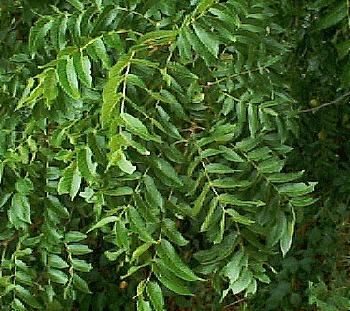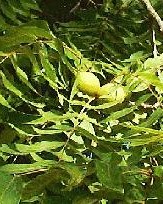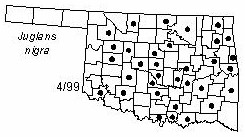

Tree to 25 m (80 ft) tall and 50 cm (20 in) in diameter with rounded crown. Bark gray to dark brown, becoming deeply furrowed into scaly ridges. Twigs thick, gray, finely hairy when young, with raised 3-lobed leaf scars, and chambered brown pith. End bud single, narrow, with paired gray hairy scales. Leaves alternate, pinnately compound, 30-60 cm (12-24 in) long. Leaflets, 9-21, broadly lanceolate, uneven at base, acuminate, finely serrate, 6-13 cm (2.4-5.1in) long, dark green, glabrous above and soft-hairy below. Staminate catkins appearing in early spring. Pistillate flowers (appearing at the same time) small and often in pairs. Fruits often in pairs, 4-6 cm (1.6-2.4 in) in diameter, with a thick pulpy husk.
Distribution: The species is native to most of the eastern half of the U. S.
Habitat: well-drained floodplain forests and moist upland forests
NWI status: FACU
Comment: Seeds are thick-shelled but delicious and are eaten by people and wildlife. The wood is commercially important in the manufacture of gunstocks and high-quality furniture. Juglans is derived from a Latin phrase meaning "acorn (or nut) of Jove"; nigra refers either to the black nut or the dark brown wood.
Distribution in Oklahoma:

BACK
NEXT
RETURN TO INDEX
Last update: 9/10/99
 Go to Oklahoma Biological Survey Home Page
Go to Oklahoma Biological Survey Home Page
 Disclaimer
Disclaimer